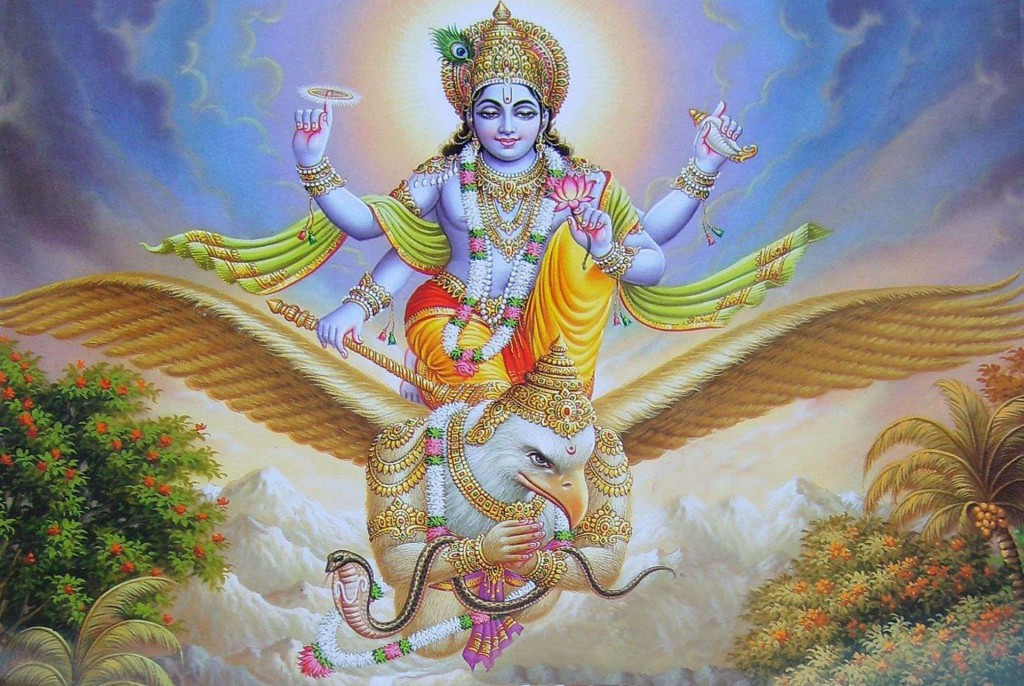No products in the cart.
Vahana means which carries or bears. It is derived from the word vaha means bearing, carrying. It is also a reference to a stream or a flow. Hence, a river is known as Vahini, that which carries. In Hinduism, Vahana has a great significance as the Vehicles of gods and goddesses. Each Hindu deity has a Vahana which is usually an animal, bird, or a mythical creature. In the following discussion, we translate the word Vahana as Vehicle and to distinguish them from the ordinary vehicles we begin the word with a capital letter. We follow the same practice for Vahana also.
The relationship between the deity and the Vehicle is not merely that of a master and servant, but almost that of a father and son, or the body and the soul. Outwardly they may appear as two entities, but internally they are united and share the same consciousness as in case of an embodied being (jiva). The Vehicles or the Vahana cannot be considered mere animals or creatures because they are endowed with the knowledge and power of the deity, which is superior to that of humans. If deity is the soul, the Vahana is his physical aspect representing the duality of beingness. In this regard, the body of each being is also a Vehicle which carries or embodies the soul. In some cases the Vehicles also double as guardians to the gates of the deity’s sphere or world, which means that without their permission you cannot reach the deity. In Hinduism worshiping the deity or worshiping his Vehicle have the same effect. Just as gods, the Vahanas have colorful names, attributes and super human features. Offerings are invariably made to them where the principal deity is worshipped, and worship remains incomplete if they are ignored. Symbolically the Vahana represent the deity’s power and status in the pantheon, and the specific energies over which they have transformative control. For example, Indra’s Vehicle is a white elephant. Elephants are usually associated with royalty. Hence, Indra’s Vehicle denotes Indra’s position as the king of the heaven and as a warrior king. Vayu Devta has thousands of horses as his Vehicle. The horses symbolize the swift, moving, power of the wind God. More importantly, the Vehicles symbolize the energies, tendencies and attitudes over which the deity has complete control. Each Vehicle symbolically represents a particular type of energy or power upon which its presiding deity has complete control both in the macrocosm of the universe as well as the microcosm of the beings. The body of each living being is a product of Nature and contain various organs and energies, which manifest as emotional states, tendencies, attitudes, instincts, desires, and passions. Some of them are positive and some negative. Depending upon how they are used and who controls them, the beings are subject to the law of karma and the cycle of births and deaths. The knowledge of the Vehicles and their presiding deities helps us in spiritual life has a great value. By knowing which type of Vehicle your body represents and which energies are predominant in it, you can work for your spiritual transformation. Just as you invoke the presence of a deity into an image saying “avahayami”, you can invoke him or her in your body for an internal ritual (manas puja). Further, if you have any physical or mental ailment, you can invoke the appropriate deity through prayers and worship to manifest in you and resolve the problem. For example, if you are prone to excess anger, or cruelty, you can invoke the power of Chandi or Durga or Kali, to reduce your anger. If you have excess passion or lust, symbolically represented by the bull, you can invoke Lord Shiva who is its controller. If you suffer from fear and self-doubt which is preventing you from taking initiative in reaching your goals, you can propitiate Ganesha who controls fear, nervousness, and hesitation represented by the rat. If you want to overcome fear of death, you can worship Shiva or Kumara who have control over snakes, which represent death. If you are suffering from loneliness or lack of abundance symbolically represented by the owl, you can worship Lakshmi. If you want to develop a swift mind and keen observation, you should worship Vishnu who keeps a close eye on the entire existence and travels swiftly at the speed of thought on his Vehicle Garuda to help people, resolve problems, or restore order. The following is a brief discussion of the symbolism of the Vahanas used by the most popular gods and goddesses of Hinduism, what they represent, and how they can help you in your self-transformation.
Brahma Vahana – Hamsa
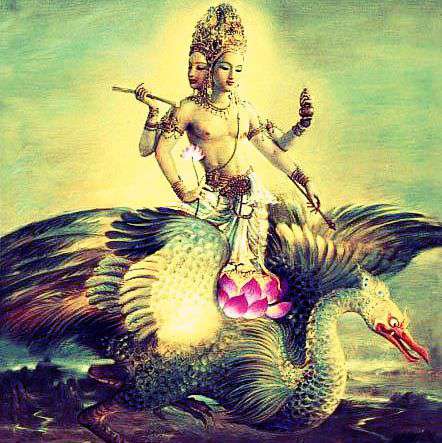
Hamsa (swan) is the Vehicle of Brahma. It stands for discerning intelligence (buddhi), purity, judgment, skill, grace, knowledge, and creativity. The word “Hamsa” is a combination of two words, “aham”+ “sa”. It means “I am He”. This awareness that one is God exists only in enlightened people. Rightly Brahma is the friend and philosopher of all the enlightened beings in the world, and he has the power to give us this knowledge about our true nature. The bird hamsa is also very beautiful, peaceful and graceful. It suggests that Brahma is the master of all the beauty and grace of the world, and He can help us in our effort to acquire these qualities. It is also believed that the bird has the capacity to separate milk from water. This symbolically means that Brahma can help us to transform our intelligence, or the buddhi, or our ability to discriminate between the rights from the wrong so that we can select the correct path to achieve salvation. The bird moves in waters, especially lake waters that are placid. The water symbolically stands for our consciousness and the lake itself for a limited consciousness such as ours. Brahma moves in our consciousness on his Vehicle hamsa and purifies it with his touch and grace. If you want to develop super fine intelligence, you should worship Brahma and invoke him in you during meditation.
Saraswati Vahana – Swan
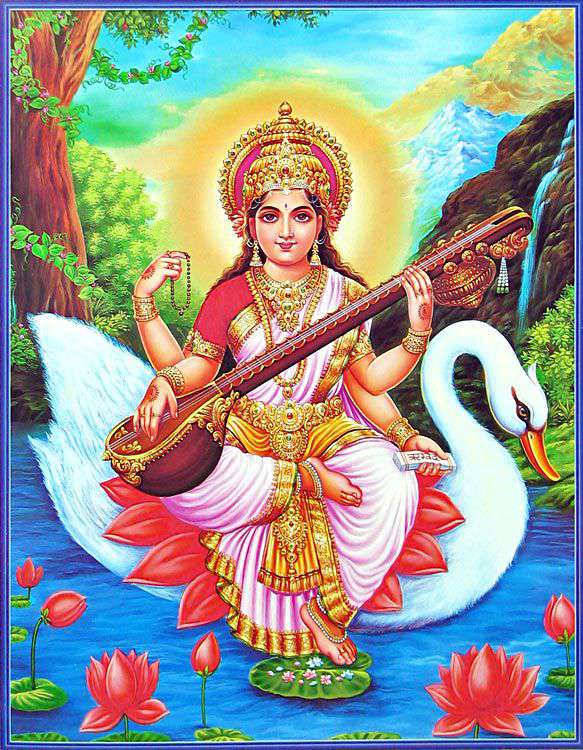
Goddess Saraswati is the consort of Brahma. She is shown riding either hamsa or a peacock. Saraswati is the goddess of learning. From education comes knowledge and refinement of character. The peacock is a gentle and beautiful bird which is known for its beauty, elegance, poise, and dancing skills. It suggests that you should seek the help of Saraswati, if you are pursuing higher education, fine arts, aesthetics or culture (Sanskriti). The peacock also eats snakes, which symbolically means that with the help of Saraswati you can control your desires, passions and fear of mortality.
Vishnu Vahana – Garuda
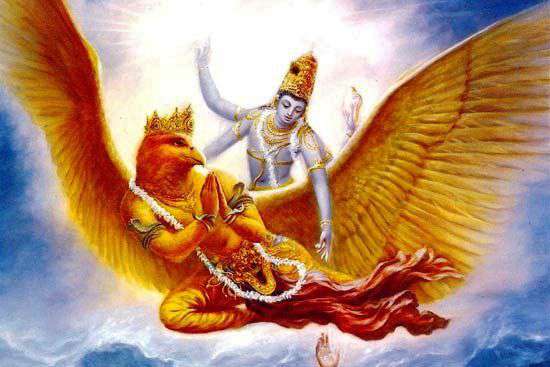
Lord Vishnu is seated on Adi Shisha, the primal serpent deity, who represents in us materiality and desire ridden consciousness. Lord Vishnu can help us either to fulfill our desires and chief aims of human life, or control them. His Vehicle is Garuda, the divine bird, which symbolically represents the human thoughts. Just as Garuda travels in all directions at incredible speeds, our thoughts also travel at incredible speeds. Hence, if you want to control undesirable thoughts and stabilize your mind, you should invoke Lord Vishnu.
Mahalakshmi Vahana – Uluka
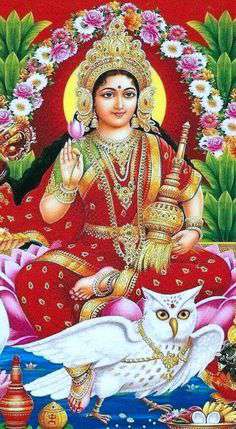
Mahalakshmi is the goddess of wealth and abundance. Interestingly Mahalakshmi has the owl called Uluka as her Vehicle. People do not want owls to enter their homes, but everyone wants the goddess of fortune to visit them and grace their homes. This presents an interesting contrast, and for a reason. The owl is a solitary creature, which remains awake during nights, but asleep during daytime. In other words, it is awaken in darkness and asleep during daytime. Thus, the owl shares a very important quality with the seers and sages or the awakened souls. As the Upanishads, affirm, the enlightened ones are awake when others asleep and they are asleep when others are awake. Therefore, for the world, the owl may be an inauspicious symbol, but in truth it is an awakened master. Secondly, like the ascetic seers the owl prefers to live in isolation and seldom seen in the company of people or any other bird. Indeed, it stays away from everyone as if it has no interest in the world or the humanity. Thus, the goddess Lakshmi represents wealth and abundance, her Vehicle represents detachment and renunciation. It means if you have wealth or if your pursue wealth, you should practice detachment and renunciation and use the money for the welfare of the others. Those who pursue riches should be aware of their attachment to wealth and pray to the goddess to inculcate in them the qualities of detachment, renunciation, selflessness, and get rid of ignorance, greed, selfishness, envy and malice so that they become truly awake in the darkness of death and adversity. The owl is also regarded as an inauspicious symbol. If a people see an owl or if an owl enters anyone’s home, it is considered an inauspicious omen. Goddess Lakshmi has the power not only to bestow wealth upon her devotees, but also to neutralize ill omens and adversity. Thus, her association with the owl also symbolizes her ability to ward off evil omens and adverse conditions.
Shiva Vahana – Nandi
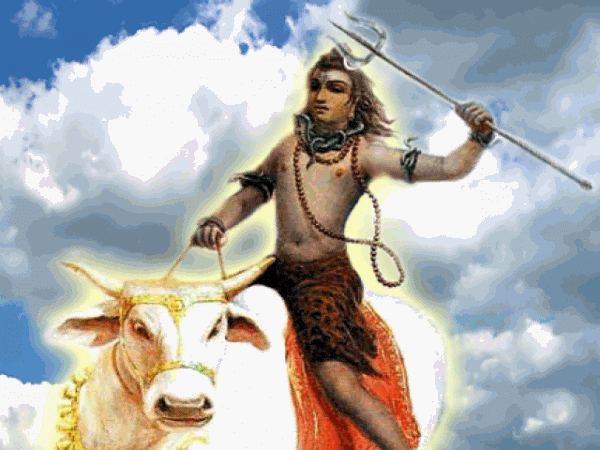
Lord Shiva rides the Bull, Nandi, which stands for the bullying, aggressive, blind and brute power in man. It also stands for unbridled sexual energy, Kama. Only Lord Siva can help us control these and transform them. They are usually manifestations of excessive tamas in the body. By invoking and worshipping Shiva one can get rid of them. Thus Shiva can transform a wild bull into a gentle and enlightened Nandi. Shiva is also considered a healer. The Vedas address him as a divine healer and point to his power over death caused by snakebites, calamities, diseases, etc. Hence, those who suffer from chronic diseases, or physical ailments, may pray to him for relief or protection from toxicity in the body, pain, suffering, and death.
Ganesha Vahana – Mooshika
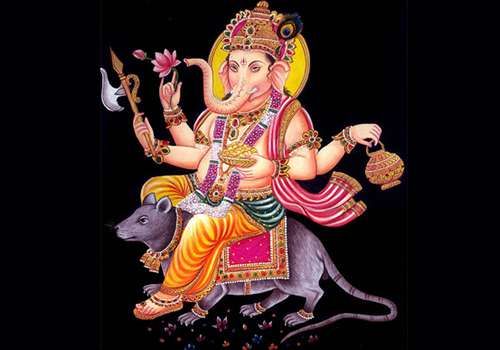
Ganesha or Ganapathi is considered the first among the gods and leader of the Shiva Ganas (brigade). He has a large body with the head of an elephant. Interestingly, he uses a tiny creature, rat as his Vehicle. Physically you cannot imagine an elephant riding on a small house rat. However there is a deep symbolism in their association. The rat symbolizes, timidity, nervousness, weakness, hesitation, fear, and self-doubt. They are largely responsible for our failures in our lives and our inability to complete the tasks we start. Fear prevents us from taking initiative and completing tasks. Lord Ganesha is known as remover obstacles. He does it by addressing our fears and helping us to control them. Therefore, if you are suffering from fear and self-doubt which are preventing you from taking timely action, you should pray to Ganesha to remove your fear and negativity, and instill in your confidence and courage.
Thus, we can see that the Vehicles of the gods and goddess of Hinduism symbolize our bodies and various energies that are present in them which can be transformed or channeled for righteous ends by propitiating their presiding deities. The Vehicles convey the deeper and hidden wisdom about the importance of seeking divine help in your physical, mental, and spiritual transformation, and your material wellbeing. You can use the knowledge to purify your mind and body, change your circumstances or overcome obstacles

